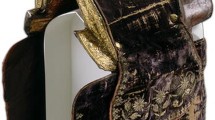Summary
The impaired formation of the diaphragma sellae may lead to the development of the empty-sella syndrome. This structure, when fully formed, is a protective barrier against the pulsating action that the cerebrospinal fluid exerts on the sellar content. There are anatomical features which support this belief, but they also suggest that the development of the diaphragma sellae is a factor which determines the morphology of the sella turcica and its contents. Those human specimens which do not have diaphragma sellae or in which it is only partially developed, are characterized by a smaller hypophysis, always located at the inferior and/or posterior half of the sella, with a larger sellar volume and frequently greater fragility of its bony walls. These findings, although rare (5% of the cases), are indirect signs of the important role which the diaphragma sellae plays in the sellar region.
Résumé
Le développement incomplet du diaphragme sellaire peut être à l'origine d'un syndrome de la selle turcique vide. Lorsque ce diaphragme est bien formée, il constitue une barrière efficace, protégeant le contenu de la selle turcique de la pression pulsatile du liquide cérébro-spinal. Des études anatomiques semblent corroborer ces données et suggèrent même que le développement du diaphragme sellaire conditionne la morphologie de la selle turcique et son contenu. C'est ainsi que l'on peut observer chez certaines personnes dont le diaphragme sellaire est absent ou partiel, l'existence d'une petite glande pituitaire qui est toujours plaquée à la partie inférieure et/ou postérieure de la selle turcique ; de surcroit, le volume de la selle est augmenté et ses parois osseuses sont plus fragiles qu'à l'accoutumée. Tous ces faits, bien que rares (5% des cas), établissent de façon indirecte le rôle important que joue le diaphragme sellaire sur la région pituitaire.
Similar content being viewed by others
References
Bjerre P, Lindholm J, Videbaek H (1986) The spontaneous course of pituitary adenomas and occurrence of an empty sella in untreated acromegaly. J Clin Endocrinol Metab 63: 287–291
Busch W (1951) Die Morphologie der Sella turcica und ihre Beziehungen zur Hypophyse. Virchows Arch [A] 320: 437–458
Calkins R (1968) Intrasellar arachnoid diverticulum. Neurology 18: 1037–1040
Caplan R, Dobben GD (1969) Endocrine studies in patients with the empty sella syndrome. Arch Int Med 123: 611–619
Chynn K (1966) Neuroradiological explorations in intra and parasellar conditions. Radiol Clin North Am 4: 93–116
Di Chiro G, Nelson KB (1962) The volume of the sella turcica. Am J Roentgenol 87: 989–1008
Du Boulay G (1966) Pulsatory movements in the CSF pathways. Br J Radiology 39: 255–259
Faglia G, Ambrosi B, Beck-Peccoz P, Giovanelli M (1973) Disorders of growth hormone and corticotropin regulation in patients with empty sella. J Neurosurg 38: 59–64
Hodgson S, Randall RV, Holman CB (1972) Empty sella syndrome. Med Clin North Am 56: 897–907
Kaufman B, (1968) The empty sella turcica — a manifestation of the intrasellar subarachnoid space. Radiology 90: 931–941
Nagata K, Joshita H, Matsui T, Kaizu H, Ishikawa T, Shigeno T, Asano T: Primary empty sella syndrome caused by an abnormal dilatation of the optic recess. Surg Neurol 31 : 323–329
Obrador S (1972) The empty sella and some related syndromes. J Neurosurg 36: 162–171
Scott RJ, Redmond MJ (1989) Non-traumatic cerebrospinal-fluid rhinorrhoea in cases of primary empty-sella syndrome. Med J Australia 150: 458–461
Vallee B, Besson G, Person N, Mimassi N (1982) Persisting recessus infundibuli and empty sella case report. J Neurosurg 57: 410–412
Weisberg L, Zimmerman E, Frantz A (1976) Diagnosis and evaluations of patients with an enlarged sella turcica. Am J Med 61: 590–596
Author information
Authors and Affiliations
Rights and permissions
About this article
Cite this article
Ferreri, A.J.M., Garrido, S.A., Markarian, M.G. et al. Relationship between the development of diaphragma sellae and the morphology of the sella turcica and its content. Surg Radiol Anat 14, 233–239 (1992). https://doi.org/10.1007/BF01794946
Received:
Accepted:
Issue Date:
DOI: https://doi.org/10.1007/BF01794946



